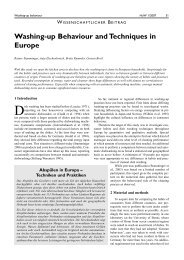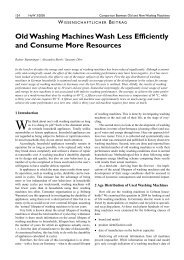Development of a novel mechatronic system for mechanical weed ...
Development of a novel mechatronic system for mechanical weed ...
Development of a novel mechatronic system for mechanical weed ...
Create successful ePaper yourself
Turn your PDF publications into a flip-book with our unique Google optimized e-Paper software.
Abstract<br />
real centre positions, in experiments conducted with RGB sensor, was 31 mm whereby<br />
50% <strong>of</strong> the samples were inside the interval 0 to 5 mm and 90% <strong>of</strong> the samples were<br />
inside the interval 0 to 16.9 mm. The maximum deviation <strong>of</strong> the estimated centre<br />
positions from the plant real centre positions, in experiments conducted with laser<br />
sensor, was 25 mm whereby 50% <strong>of</strong> the samples were inside the interval 0 to 3 mm<br />
and 90% <strong>of</strong> the samples were inside the interval 0 to 6.9 mm.<br />
The servo <strong>system</strong> built in the physical prototype was operated in a mode with direct<br />
s<strong>of</strong>tware control providing rotational speed adjustment according to the <strong>for</strong>ward speed<br />
<strong>of</strong> the carrier, intra-row distance between successive crop plants and the observed<br />
angular position <strong>of</strong> the arms. The controlling algorithm and s<strong>of</strong>tware solution were<br />
developed in the Labview® environment. The main task <strong>of</strong> the controlling s<strong>of</strong>tware was<br />
permanent calculation, checking and change <strong>of</strong> the recent rotational speed <strong>of</strong> the<br />
hoeing tool in real time. The s<strong>of</strong>tware solution used an extended version <strong>of</strong> the<br />
s<strong>of</strong>tware previously developed <strong>for</strong> detection <strong>of</strong> the plants’ centre position.<br />
Tests have proved that depending on the angular adjustment <strong>of</strong> the arms carrying the<br />
duckfoot knives an uncultivated area big enough to avoid damaging <strong>of</strong> the plants can<br />
be left around the plants during the intra-row <strong>weed</strong>ing with the developed <strong>system</strong>.<br />
The <strong>system</strong> is able to autonomously adapt the rotational speed <strong>of</strong> the hoeing tool in<br />
case <strong>of</strong> non-intensive <strong>for</strong>ward speed change. After rapid <strong>for</strong>ward speed change,<br />
several plants can be damaged while the <strong>system</strong> stabilises its work, but stable state<br />
can be reached immediately after the stabilisation period.<br />
The presented concept <strong>of</strong> the intra-row hoeing <strong>system</strong> can fulfil the requirements; it has<br />
sufficient degrees <strong>of</strong> freedom to allow full adaptation to different crop and vegetable<br />
species, different plant intra-row distances and plant growth stages. In combination<br />
with an inter-row hoe or installed on an autonomous vehicle, the developed robotic<br />
<strong>system</strong> could be a solution <strong>for</strong> accurate and rapid <strong>mechanical</strong> <strong>weed</strong> control.





